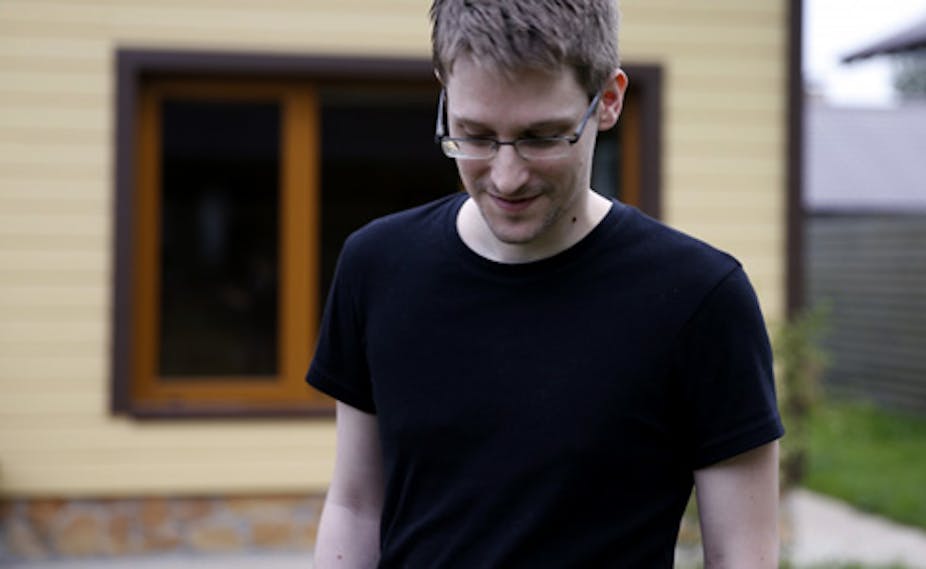Laura Poitras’s much-anticipated Citizenfour is now on general release. A documentary about the whistleblower Edward Snowden, the film provides an admirable summary of the issues raised by the beginnings of what might be called the “Snowden era,” when the extraordinary revelations of mass surveillance were brought to light.
The film covers the period from Snowden’s initial approach to Poitras in February 2013 to an interview with him in his Moscow exile in May 2014. Poitras provides us with a fly-on-the-wall perspective throughout crucial and tense moments, giving insight into not only the motivations, but also the concerns and fears that surround the leaks and their publication.
We get to know a whistleblower who is articulate and considered in his dealings, and to understand the significant personal risks he took in coming forward. Sitting in a hotel room in Hong Kong with Poitras and journalists Glenn Greenwald and (later) Ewen MacAskill, he calmly explains the pervasive system of mass surveillance that he discovered through his work with the NSA, as well as his justifications for exposing it.
A new era
Snowden expresses a deep-felt disillusionment with what he views to be excessive powers of the intelligence agencies following 9/11, and a particular disappointment with president Obama, who he sees as extending rather than curtailing these powers. Snowden is therefore motivated not by hostility towards state power or intelligence agencies per se, but rather by the excessive powers of these agencies in relation to citizens.
Snowden notes a reversal in the relationship between the rulers and the ruled in terms of their ability to hold power to account. This invites one of the most important questions of the film: what, then, are the perceived necessary powers that secret services and intelligence agencies should hold in a contemporary democratic society? Elsewhere Snowden has framed this debate by particularly criticising the move from targeted to mass surveillance. Earlier limits to state power, such as the requirement of a warrant in order to collect data on specific individuals, have been given up to collect all data by everyone at any time.
Yet the film also demonstrates that even a system of “targeted” surveillance is open for abuse: it ends with a new whistleblower coming forward, revealing that 1.2m people are on the NSA watch-list. With the ability to “target” such vast numbers of people, definitions of “targets” can easily and simply become political tools for maintaining social control. And they’re made even more dangerous by pertaining to some pretence at accountability.
Risk and fear
Citizenfour also tells the story of the risks and challenges that whistleblowers and journalists face in today’s swiftly mutating news environment. The Snowden leaks are exemplary of these contemporary times. Greenwald, in the biggest scoop of his career, brought in the expertise of MacAskill and the editorial team at The Guardian in the lead-up to the publications of the leaks. At the same time, new forms of journalist organisations such as Wikileaks facilitated Snowden’s departure from Hong Kong and his exile in Moscow, and technological activists like Jacob Appelbaum contributed and provided context for several of the leaked publications.
Surrounding the Snowden leaks, therefore, we find a connected network of old, new, radical and traditional media actors: the documentary maker (Poitras), the whistleblower (Snowden), the “advocacy” journalist (Glenn Greenwald), the “traditional” editors (Ewen MacAskill and Alan Rusbridger), and the “hacktivists” (Wikileaks and Jacob Appelbaum) working in conjunction – a vivid example of what media scholar Yochai Benkler has called a “networked fourth estate”.
This is a film that highlights how this networked fourth estate circulates around and intersects with a state that, in the face of damaging revelations, will take extreme measures to try and suppress this information reaching the public.
In fact, this film holds particular significance for a UK audience. Snowden, in his first meeting with MacAskill, casually mentions that the levels of mass surveillance carried out in the UK through the GCHQ programme Tempora are far broader than those by the NSA. And it features the extraordinary footage of staff at the Guardian being forced to destroy computers and files on request of the UK government. Rarely has the question of press freedom today been more graphically illustrated.
This is not to mention that neither Poitras nor Greenwald could be present at the premiere of the film in London following advice by their lawyers that the British Terrorism Act puts them at risk of arrest for their reporting. Both attended the premiere of the film in New York a week earlier.
Although the Snowden leaks continue to play out with a focus on the US, all this stresses some very troubling questions about the UK – not only about the activities of our state agencies, but also the freedoms in place for our press to report on them.

